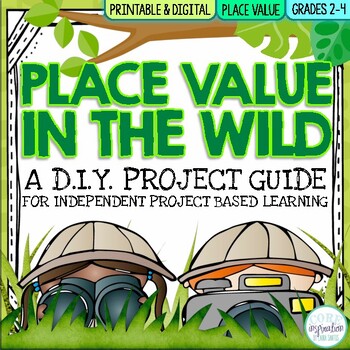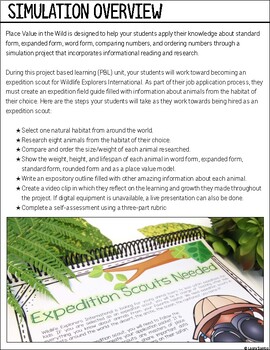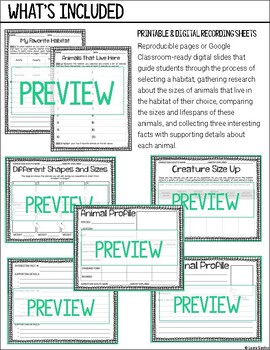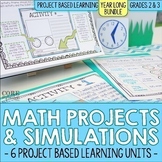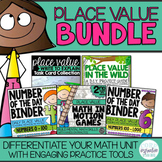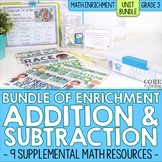Place Value Math Project | Print & Digital Project Based Learning for Math
- Zip
- Google Apps™

What educators are saying
Also included in
- The 6 math projects included in this bundle are designed to help your 2nd and 3rd grade students exercise application and analysis skills for six different math topics:Place Value (Place Value in the Wild Project)Telling Time & Elapsed Time (Time of Your Life Project)Geometry (Quadrilateral CityPrice $33.96Original Price $42.45Save $8.49
- The 5 place value resources in this bundle are designed to make your second grade place value unit more engaging for students through differentiated learning. The collection of resources includes something special for the unique learners in your classroom. Give your students opportunities to solidifPrice $29.60Original Price $37.00Save $7.40
- These 3rd grade addition and subtraction extension and enrichment activities aren’t busy work. They help your students develop a deeper understanding of addition and subtraction concepts through:★ Hands-on games that foster conversations about math. ★ Carefully crafted word problems that require modPrice $21.60Original Price $27.00Save $5.40
Description
Bring your place value unit to life with this project based learning (PBL) experience. This place value project is designed to help your students apply their knowledge about standard form, expanded form, word form, comparing numbers, and ordering numbers through a simulation project that incorporates informational reading and research.
A digital and printable version of this resource are included making it easy to use whether you are teaching in person, using digital learning, or a combination of both.
During this project based learning (PBL) unit, your students will work toward becoming an expedition scout for Wildlife Explorers International. As part of their job application process, they must create an expedition field guide filled with information about animals from the habitat of their choice.
***************************************************************************
STEPS STUDENTS WILL TAKE DURING THIS MATH PROJECT:
Here are the steps your students will take as they work towards being hired as an expedition scout during their Place Value in the Wild Simulation:
★ Select one natural habitat from around the world.
★ Research eight animals from the habitat of their choice.
★ Compare and order the size/weight of each animal researched.
★ Show the weight, height, and lifespan of each animal in word form, expanded form, standard form, rounded form and as a place value model.
★ Write an expository outline filled with other amazing information about each animal.
★ Create a video clip in which they reflect on the learning and growth they made throughout the project. If digital equipment is unavailable, a live presentation can also be done.
★ Complete a self-assessment of their project using a three-part rubric.
***************************************************************************
WHAT’S INCLUDED:
★ Teacher's Guide - detailed steps for successfully incorporating this resource in your classroom. This guide includes tips on:
- Implementing this project in a variety of ways
- Prepping your project materials efficiently
- Setting a deadline
- Introducing the project through a mini lesson
- Wrapping up the project in a meaningful way
- Using this project with Google Classroom
★ Digital and Printable Student Guide - a printable and digital version of the student guide is included. This 34-page guide includes detailed instructions and visuals to help your students complete each step of this simulation successfully. The format of this guide makes differentiation easy. Use it as a supplement to your verbal instructions as you provide scaffolding, or let your more advanced students work through each step of the project independently.
★ Student Printables - reproducible pages that guide students through the process of selecting a habitat, gathering research about the sizes of animals that live in the habitat of their choice, comparing the sizes and lifespans of these animals, and collecting three interesting facts with supporting details about each animal.
★ Digital Recording Sheets - the student printables are also provided in a ready-to-use Google Slides files that can easily be shared with your students via Google Classroom.
★ Editable Rubrics - three 4-point rubrics students can use to self-assess their ability to apply place value skills, create a field guide, and organize the components of their project. The same rubrics can be used by the teacher to provide a score for student work. An editable version of each rubric is also included.
★ Completed Project Sample: A completed sample of the project to help you provide scaffolding to students as needed.
***************************************************************************
PEDAGOGY:
This math project based learning unit requires the application of students’ knowledge of place value. Throughout the process of the Place Value In The Wild simulation, students will have the opportunity to apply their knowledge through creative design, engage in informational research that incorporates their math knowledge, and build organization skills as they plan and execute this multi-day project.
Every step of the Place Value In The Wild learning experience is outlined in a project guide that includes clear visuals and step-by-step instructions. Rubrics and reflection prompts will encourage your students to reach their learning goals.
The format of this place value project gives students the opportunity to exercise the standards for mathematical practice, apply math in real world situations, and display understanding in unique and engaging ways.
The format of the project based learning guide makes it an ideal resource for:
★ At your seat & hands on enrichment during math workshop or guided math
★ Math center work
★ Digital learning (a Google Slides version of the entire project is included)
★ Parent volunteer or teacher’s aide enrichment station
★ A focal point for a place value room transformation
★ An alternative assessment that allows you to measure student understanding on a deeper level as a culmination to your place value unit.
***************************************************************************
BOOSTING RIGOR:
Students who have mastered the ability to read and express numbers in standard form, expanded form, word form, compare numbers, and order numbers will have the opportunity to extend their learning and deepen their understanding of place value through this math project based learning experience.
This math project will help them solidify the place value skills they’ve mastered through real world problem solving rather than being bogged down with worksheets or busy work.
This project also serves as a wonderful alternative assessment that allows you to measure student understanding on a deeper level as a culmination to your place value unit.
***************************************************************************
BUILDING STUDENT INDEPENDENCE:
This project guide is designed with student independence in mind. Detailed instructions and checklists are provided for students so they can carry out their project with maximum independence.
You can guide them as needed, and pull small groups during your math block that help address the more individualized needs of your students. This allows students to work at their own pace and take ownership of their learning.
On the day of the project launch, you will take 15-20 minutes to set the scene and teach students how to navigate their project guide. After that, your students will be off on an independent math project based learning (PBL) adventure that will last for days.
***************************************************************************
SAVING TIME:
Want to incorporate a project into your place value math unit, but crunched for instructional time?
This resource makes prepping for project based learning a breeze and makes implementation seamless. The detailed visual instructions on each page of the guide make it possible for students to complete their unique project with maximum independence so you have the time you need to teach or reteach essential place value skills to small groups.
Scoring and providing students with feedback is also when using the included rubrics. Each of the three project phases: preparation, field guide creations, and project assembly has its own rubric so students can participate in the assessment process as they demonstrate learning, and you can provide them with specific feedback about their work.
***************************************************************************
WHAT TEACHERS THINK OF THIS PROJECT:
♥ “Love how explicit the directions are, including visuals! Such a great project that allows students to practice speaking, writing, reading, AND math standards! Awesome product!” - Teach You Howe
♥ “Wow, did my students love this! My higher achievers soared with this project. It was perfect for challenging them. I will buy more from you in the future!” - Elyce H.
♥ “This has been such an amazing way to incorporate place value and research into my math lessons. The kids love that they are in charge, and I love that we are working on such a wide range of skills. Thank you!” - Bailey C.
♥ “This was a wonderful project that really pushed some of my second grade students to master place value while integrating research and writing! My students absolutely loved this as did I! This was my first PBL experience and I couldn't be happier with this purchase. The entire project was extremely organized and all of the directions were very clear with great pictures and examples. Thank you for putting in so much time into this resource!” - Christine Y.
♥ “Project based learning is so new to me and this resource was a great first step in learning how to implement it in my classroom! Thank you for the resource.” - Emily C.
***************************************************************************
OTHER MATH PROJECTS BY CORE INSPIRATION:
★ Place Value In The Wild - Place Value PBL Unit
★ The Time of Your Life - Telling Time PBL Unit
★ Conversation Hearts & Data Smarts - Data & Graphing PBL Unit
★ Winter Wonderland Array Architects - Arrays & Multiplication PBL Unit
★ Measure-Thon - Measurement PBL Unit
★ Quadrilateral City - Geometry PBL Unit
***************************************************************************
LET'S CONNECT: ★ The Core Inspiration Blog ★ Instagram ★ Pinterest ★ Facebook ★

